The Woman Behind the Biggest Heart in the World
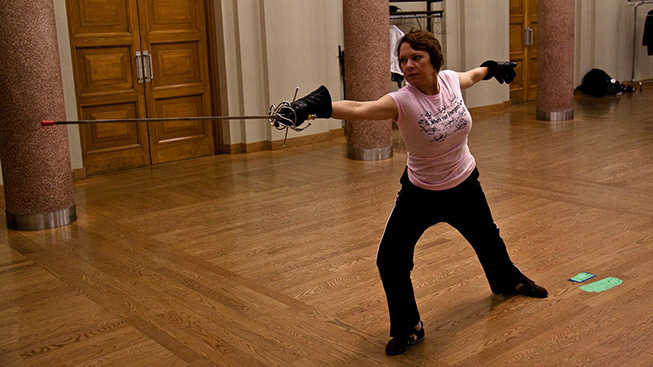
Guest Blog written by 2017 Environmental Visual Communication student Fenella Hood
Knife in hand and knee-deep in rotting blubber, Jacqueline Miller is about to do something that has never been done before: carve out a blue whale's heart for preservation. Enveloped in its stench and racing against decay, she cuts deep into the tissue beneath, sure in her knowledge of anatomy but ever wondering: Will this even work?
Backtrack two months.
Jacqui has just been given the coveted position of Mammalogy Technician at the Royal Ontario Museum in Toronto. It is March 2014. She is embarking on her career in a place she is familiar with, having worked in collections at the ROM throughout her undergrad, Masters and PhD at the University of Toronto. Her boss is Mark Engstrom, the ROM's Senior Curator of Mammals and Deputy Director of Collections and Research, who has just returned from Newfoundland where he and his team have stripped a blue whale carcass down to its bones.
Her boss is excited, for there is not one but two blue whale bodies offering themselves up for science on the shores of southwest Newfoundland. Its now up to Jacqui to drop everything and go get what she can from whale number two: skeleton, tissue, and, "oh!--do everything you can to see if you can get us the heart, will you?" Engstrom has a twinkle in his eye as she leaves to pack her bags.
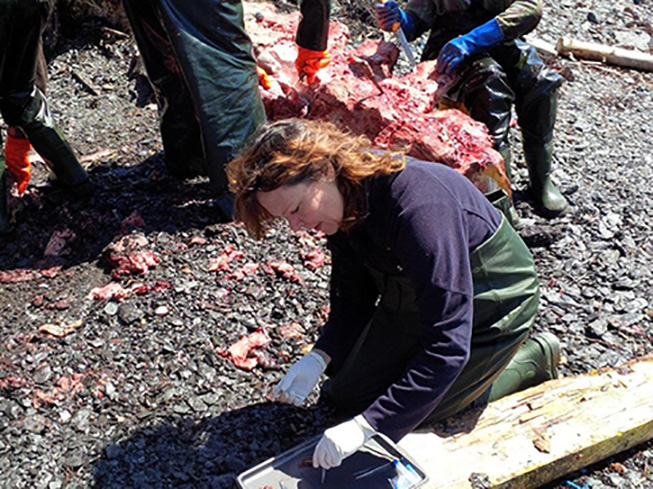
I met Jacqui in May 2017 on my first week at the ROM as a student of the Environmental Visual Communication graduate certificate program offered by Fleming College and takes place at the ROM. My classmates and I were treated to a private tour of the hugely popular exhibition Out of The Depths: The Blue Whale Story during our Curatorial class with instructor Dave Ireland, Managing Director of Biodiversity at the ROM. The course was designed to give us a behind-the-scenes perspective of the museum, teaching us about the interconnections between science and communication in a museum setting, and inspiring us to tell stories that can effect change in the world. Our other tour guides were two scientists: Burton Lim, an Evolutionary Biologist and the Assistant Curator of Mammals at the ROM, and Jacqui, both integral members of the team that brought the blue whale's story to life. They led us through the state-of-the-art exhibition, describing each component of the gallery in their own words.
I was awe-struck. It wasn't only the magnitude of the display or the wealth of information that impressed me, it was also the individuals whose stories I was listening to. I have been lucky to visit museums around the world, but I’ve never spent much time thinking about how the content they hold is created for the public, or about who is behind the displays that I experienced. I’d never been able to put a face to the exhibits that educate, advance and preserve knowledge for so many people.
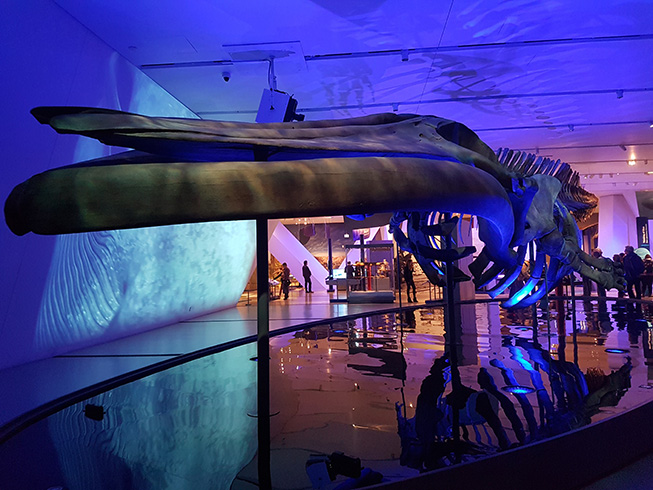
Back to May 2014, Rocky Harbour, Newfoundland: Jacqui faces a blue whale in the flesh for the first time in her life. Humbled by the weight of her task, but emboldened by her strong background in comparative anatomy and a do-or-die attitude, she begins to decipher tissue from vein from artery; left ventricle from right. “Anatomy was the least of my worries”, she says. “Finding the heart in a big puddle was another matter.”
In the soupy decomposition, Jacqui isolates the pericardial sac: a membrane that surrounds the heart and sits between the lungs and the centre of the chest. The greater blood vessels poke through the pericardium like fingers in a glove. Confident in her cuts, she moves on to the invagination (turning inside out) of the blood vessels. By the end of her first day in Newfoundland she has extracted the pancaked heart from dead grey flesh, and packed it into an ice-filled crate bound for Trenton, Ontario. With her task accomplished, Jacqui is excited about the potential for this one-of-a-kind acquisition. If successfully dissected and preserved, the heart will be a first for the scientific exploration of what a blue whale's heart really looks like, and so much more anatomical research data. But Jacqui is apprehensive. Did she get all of the essentials? “I was sure I had cut a part of the heart off”, she says. “There is a very short connection in the region where the inferior vena cava drains into the heart and its proximity to the diaphragm. It was the hardest part of the dissection, trying to make sure I was not cutting into the atrium of the heart itself.”
It would be two years before Jacqui would know if all her work to try and preserve the organ had been in vain.
The story of the blue whale's journey to the ROM is full of nerve-wracking moments of challenge, conflict and mystery: Should we extract the heart? Has it deteriorated beyond preservation? Where can we prepare it? Can it be done? But in the end, it was a once-in-a-lifetime opportunity that the ROM could not pass up. When whales die, most of them sink to the bottom of the ocean. It’s uncommon for their bodies to wash ashore, and if they do, they are usually past the point of organ salvage. The ROM's blue whales were trapped in sea ice in the Gulf of St. Lawrence where they perished from starvation. They remained impaled and frozen on ice floes until spring floated them to shore. They had to work fast if a viable specimen was to be collected.
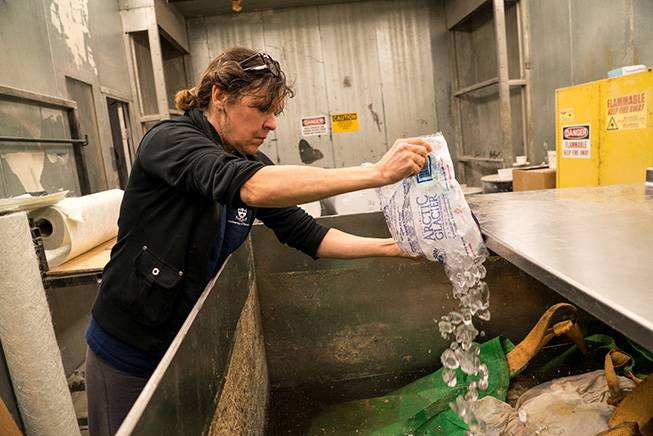
After the necropsy, Jacqui traveled to Research Casting International in Trenton, Ontario where the heart would lie fixed in formaldehyde for three months. The volatile liquid cross-links tissue causing it to go rubbery, so the heart could take on its original shape – except nobody was quite sure what that shape was supposed to look like. Jacqui and the team had to inflate the heart to a natural size to get an idea of what it should look like. “We needed to seal off all the vessels that enter and exit from the right and the left sides, so that when in formaldehyde, it would puff up like a big beach ball.” A trip to the hardware store later, and buckets, pop bottles, tubes and other gadgets of all sizes, including a plunger, were McGyvered into place like a child fitting plastic circles and triangles into a toy's holes. “But, there were some areas of damage and incompetence to the heart, like a slip of the knife, and it wouldn't stay inflated,” she said. “So we had to continuously leave pumps on and circulate to try and keep it from collapsing while preserving, constantly adding fresh formaldehyde, and turning the heart so all sides become fixed.” Skilled in chemistry but used to working with smaller volumes, managing such a large amount of noxious chemicals is “never pleasant”.
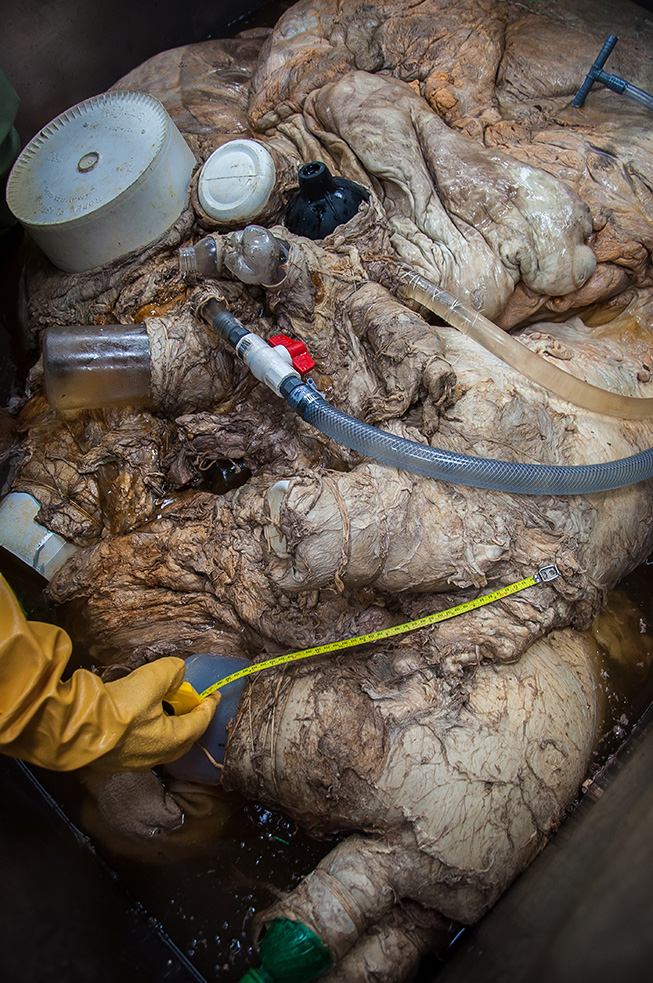
After leaving the heart to simmer in its chemical bath in Trenton, Jacqui headed down to Toledo, Ohio to learn the dangerous process of plastination. Made famous by international exhibits like Body Worlds, plastination is the process by which the heart would be dehydrated with 22,000 litres of flammable acetone and then injected with a polymer via a vacuum chamber. It is here that Jacqui hit a roadblock: “In order to plastinate the massive specimen, a chamber of sufficient size is required to bring air down to a total vacuum. With such a tremendous force, if the chamber is poorly designed the risk of an implosion great enough to destroy a large building is substantial.” It was a risk the ROM decided not to take. As gung-ho as she was to at the idea of having her first plastination project to be such a unique and rare specimen, it was also a lot of performance pressure. “It would have been nice to have a complete Canadian story-line,” Jacqui said, however, “It was quite an undertaking, and it would have been cool to say you were the one that injected the blood vessels, but that is the only specimen that is out there, the only one we will ever get, and it was best left in the hands of the experts.”
So she and a team of eight people from the ROM and RCI spent a full day getting the heart ready to ship to Gubener Plastinate in Germany, and the von Hagens family – where the process of plastination was invented in the 1970's.
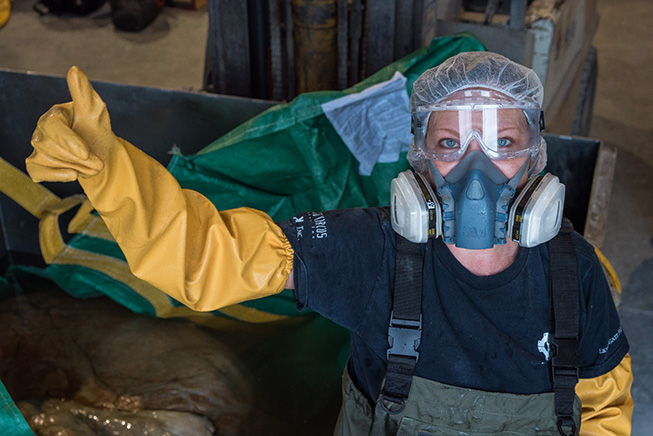
“Nobody knew how well it was going to work. Gunther von Hagens says: 'Garbage in, garbage out': If it is a good specimen, there will be a good result. But there were spots of necrolysis. Rotten material doesn't fix in formalin, so it was a promising sign when we managed to fix the heart, but even still, nobody really knew.”
Finally, in May 2016, Jacqui's worries were laid to rest. After spending many months in a dehydration chamber, the heart emerged whole and intact. When she saw the images from Germany, Jacqui knew that she and the team had been successful in correctly dissecting an adequate proportion of all the vessels of the blue whale's heart. “It was the most exciting moment after last seeing it in formaldehyde and buckets, bottles and tubes. I thought: Oh, this is gonna be good. This looks like a heart--like something that is going to have a lot of appeal.”
A few weeks after our private tour of the blue whale exhibit, the heart finally arrived at the museum. Our class was granted exclusive access to the long-awaited event, and we stood alongside the media to document the impressive installation. I watched Jaqui's face as the crate was opened and I imagined the pride that she must be feeling at this moment. I asked her to confirm this, but Jacqui surprised me with her response. “I didn't have much feeling for it at that point. I think I over-invested in the whole project. But it was good to see how people reacted, because you never know. For me, it is beautiful; a gorgeous anatomical specimen. You couldn't have asked for better from a Renaissance anatomy textbook drawing. But for a lot of people it is macabre, gross, disgusting.”
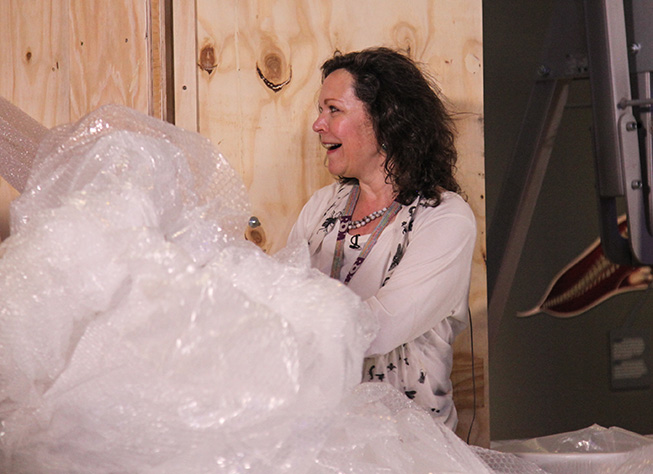
“No one knew at any point in this story whether it was going to work, right up to the exhibition,” Said Jacqui. “For me, it was that this could go either way: either have all the hype that we think we are going to have or tank and go in the other direction. And that would have been a colossal disappointment because a lot of resources were expended into that specimen, and it is a huge asset for the museum. But we see it all the time with natural history; people can't get beyond the superficial nature of looking at a dead specimen to appreciate the science curated collections are all about, the information and natural heritage that is preserved, and why we need to have them as vouchers for current and past biodiversity.”
Jacqui continued, saying, “I think it is scientists’ fault that people can have a negative reaction to science and don't have avenues to understand why it is important to get beyond the surface to understand what is lying beneath. We don't do enough to make understanding available. That is why the ROM's Environmental Visual Communication program is so important because when people do have a story behind what it is and what we do and what we are trying to preserve, and the importance of it--then there is a lot more interest and positivity.”
It felt good that Jacqui was a supporter of my current academic endeavours. I also believe that through storytelling we can relate to each other and the world we live in more effectively, and that can bring about positive change. I enjoyed listening to Jacqui's detailed recounting of her journey with the heart, and am glad to have put a face to the Blue Whale Story.
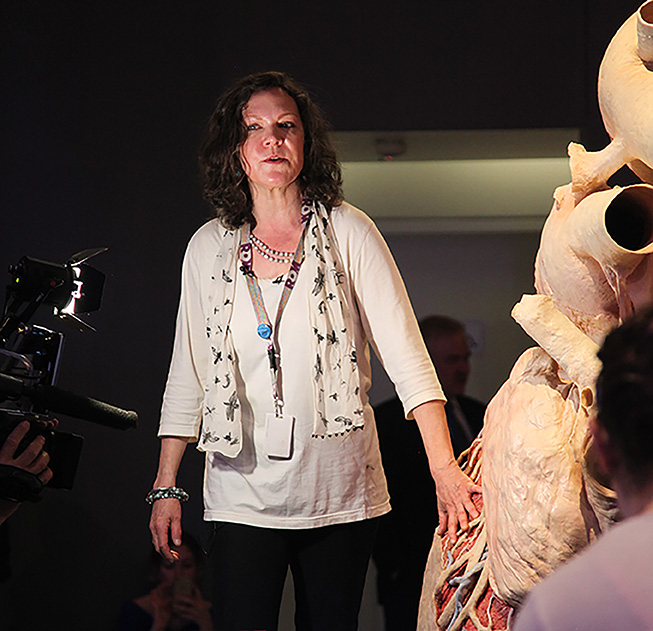
So what's next for Jacqui? Another whale, of course. “I would love to do a sperm whale. Retrospectively, now that I have done one, I have a whole bucket list of things that I would like to look at. It is hard to know the first time round, but I would have loved to have got at the vocal tract and air sacs of the blue whale, but it was not the focus at the time. We almost got up to the Northwest Territories to do a bowhead recently, but the polar bears won.”
Since my interview with her in June, Jacqui went to Prince Edward Island where she assisted with the necropsy and recovery of a skeleton from one of the growing number of endangered North Atlantic Right whales that have been washing ashore on Canada’s East Coast this summer.
To see the incredible blue whale heart and so much more of the story, be sure to visit the ROM's Out of The Depths: The Blue Whale Story before it closes on September 4th, 2017.
